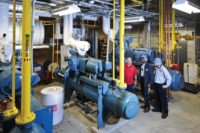As leaders of one of our nation’s safest and most highly regulated industries, dairy manufacturers have long understood the benefits of keeping our products safe for consumers. As you are aware, the new Food Safety Modernization Act (FSMA) will require all dairy food processors to implement new standards of food safety compliance by July 3, 2012. This includes having a written preventative controls plan to identify potential contamination hazards in your plant and describe how you will prevent or resolve them. FSMA requires your plan to have these five components:
1. Evaluation of hazards that could affect food safety
2. Specific preventative steps or controls
3. Specific monitoring procedures
4. Maintenance of routine records
5. Specific actions to correct problems
While you certainly have the option to create your own preventative controls plan from scratch, there are several models already in existence that will save you the time, effort and expense. I recommend a good Hazard Analysis Critical Control Point (HACCP) system to help ensure your plant is in compliance with FSMA. What makes HACCP a good choice? Let’s look at the basics.
What is HACCP?
Hazard Analysis Critical Control Point (HACCP) was first developed by Pillsbury and the U.S. Army in 1959 as a response to NASA’s request to manufacture food products safe for space travel. The concept went public in 1971. Essentially, HACCP is a system designed to ensure the safety of your food products, protect your consumers and protect your business. Come July, a detailed hazard analysis plan is the first thing the Food and Drug Administration inspectors will be asking to review when they visit your plant. A good HACCP plan provides a detailed structure to help you comply with FSMA requirements. It should contain the seven basic HACCP principles:
1. Conduct a hazard analysis and identify control measures
2. Identify Critical Control Points
3. Establish Critical Limits
4. Monitor each Critical Control Point
5. Establish corrective action to be taken when a Critical Limit deviation occurs
6. Establish verification procedures
7. Analyze and update plan regularly
Appointing a HACCP team (employees involved in your technical processes as well as other plant functions) to develop, implement and maintain your HACCP plan is essential to successful compliance with FSMA.
Hazard analysis and preventative controls
While I can’t cover every detail of a HACCP system here, I can give you some highlights. The first step in developing a HACCP-based system is to conduct a thorough analysis that identifies and evaluates potential hazards associated with your product or process, and establishes preventative controls, including Critical Control Points. A “hazard” is any biological, chemical or physical agent that is reasonably likely to cause illness or injury if it is not controlled.
A Critical Control Point (CCP) is any step in your process where a control can be applied and is essential to prevent a hazard or reduce it to an acceptable level. For example, a hazard analysis in dairy processing could identify pasteurization as the critical control point. Your CCP Critical Limits (CL) would be the minimum pasteurization holding temperatures and times, which is defined as 161 degrees F for 15 seconds in the Grade “A” Pasteurized Milk Ordinance. A CL is a maximum and/or minimum value set to prevent, eliminate or reduce the CCP hazard to an acceptable level.
CCPs under HACCP require that monitoring, verification, corrective action and record keeping procedures be established in order to ensure that CCPs are properly implemented, that CLs are met and the process is under control.
Under FSMA, preventative controls may also include: safety of process water; cleanliness of food contact surfaces; prevention of cross contamination; maintenance of hand washing; protection of food, packaging and food contact surfaces; proper labeling and storage of toxic compounds; employee health conditions and hygiene training; exclusion of pests; environmental monitoring; and supplier and food allergen control programs. FSMA will also require training of employees and supervisors. Most processors already have a preventative controls program in place that may be sufficient to meets the requirements of FSMA.
Monitoring and corrective actions
FSMA and HACCP require your plan to include documentation of how you monitor your CCPs and the actions you will take to correct any controls that are ineffective or not properly implemented. Inspectors will want to see what you plan to do to correct the problem and reduce the likelihood that it will happen again. Your monitoring and corrective action plans need to include how you will: evaluate affected food for safety; segregate and hold the affected product; determine acceptability for distribution; and prevent it from entering into commerce. You’ll also need to identify how you’ll correct the cause of the deviation from your CCP.
Verification and validation
HACCP provides guidance for establishing the verification and validation steps required by FSMA. FSMA verification is similar to an internal plant audit of your operational practices. It simply “verifies” that you are actually practicing the steps you’ve laid out in your written hazard plan and that those steps are functioning effectively. Validation is a periodic “hands on” evaluation of your written plan to ensure that your plan is consistent with current science and technology standards.
Records and re-analysis
Finally, FSMA requires you to maintain records of your actions including: monitoring of preventative controls and instances of nonconformance having to do with food safety and verification processes (such as test results). Records must be kept for two years. Re-analysis of your entire hazard prevention plan will be required every three years.
I suspect the majority of the dairy food companies already have preventative controls in place that may meet FSMA standards. The new regulations will require the industry to review — and possibly enhance — its hazard management and documentation. I believe a robust HACCP system is the most effective way to achieve that goal and assure compliance with FSMA. The good news is that you don’t have to start from scratch. There are fully developed HACCP models ready for implementation. IDFA has developed HACCP models specifically for dairy and juice processing facilities. For more information about our HACCP program and training, visit our website: www.idfa.org and search for HACCP.


